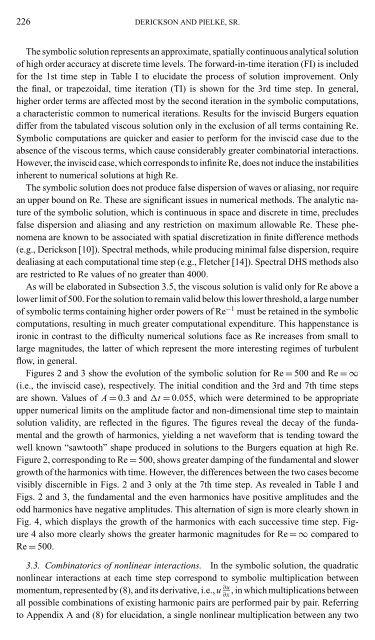A Preliminary Study of the Burgers Equation with Symbolic ...
A Preliminary Study of the Burgers Equation with Symbolic ...
A Preliminary Study of the Burgers Equation with Symbolic ...
You also want an ePaper? Increase the reach of your titles
YUMPU automatically turns print PDFs into web optimized ePapers that Google loves.
226 DERICKSON AND PIELKE, SR.<br />
The symbolic solution represents an approximate, spatially continuous analytical solution<br />
<strong>of</strong> high order accuracy at discrete time levels. The forward-in-time iteration (FI) is included<br />
for <strong>the</strong> 1st time step in Table I to elucidate <strong>the</strong> process <strong>of</strong> solution improvement. Only<br />
<strong>the</strong> final, or trapezoidal, time iteration (TI) is shown for <strong>the</strong> 3rd time step. In general,<br />
higher order terms are affected most by <strong>the</strong> second iteration in <strong>the</strong> symbolic computations,<br />
a characteristic common to numerical iterations. Results for <strong>the</strong> inviscid <strong>Burgers</strong> equation<br />
differ from <strong>the</strong> tabulated viscous solution only in <strong>the</strong> exclusion <strong>of</strong> all terms containing Re.<br />
<strong>Symbolic</strong> computations are quicker and easier to perform for <strong>the</strong> inviscid case due to <strong>the</strong><br />
absence <strong>of</strong> <strong>the</strong> viscous terms, which cause considerably greater combinatorial interactions.<br />
However, <strong>the</strong> inviscid case, which corresponds to infinite Re, does not induce <strong>the</strong> instabilities<br />
inherent to numerical solutions at high Re.<br />
The symbolic solution does not produce false dispersion <strong>of</strong> waves or aliasing, nor require<br />
an upper bound on Re. These are significant issues in numerical methods. The analytic nature<br />
<strong>of</strong> <strong>the</strong> symbolic solution, which is continuous in space and discrete in time, precludes<br />
false dispersion and aliasing and any restriction on maximum allowable Re. These phenomena<br />
are known to be associated <strong>with</strong> spatial discretization in finite difference methods<br />
(e.g., Derickson [10]). Spectral methods, while producing minimal false dispersion, require<br />
dealiasing at each computational time step (e.g., Fletcher [14]). Spectral DHS methods also<br />
are restricted to Re values <strong>of</strong> no greater than 4000.<br />
As will be elaborated in Subsection 3.5, <strong>the</strong> viscous solution is valid only for Re above a<br />
lower limit <strong>of</strong> 500. For <strong>the</strong> solution to remain valid below this lower threshold, a large number<br />
<strong>of</strong> symbolic terms containing higher order powers <strong>of</strong> Re −1 must be retained in <strong>the</strong> symbolic<br />
computations, resulting in much greater computational expenditure. This happenstance is<br />
ironic in contrast to <strong>the</strong> difficulty numerical solutions face as Re increases from small to<br />
large magnitudes, <strong>the</strong> latter <strong>of</strong> which represent <strong>the</strong> more interesting regimes <strong>of</strong> turbulent<br />
flow, in general.<br />
Figures 2 and 3 show <strong>the</strong> evolution <strong>of</strong> <strong>the</strong> symbolic solution for Re = 500 and Re =∞<br />
(i.e., <strong>the</strong> inviscid case), respectively. The initial condition and <strong>the</strong> 3rd and 7th time steps<br />
are shown. Values <strong>of</strong> A = 0.3 and t = 0.055, which were determined to be appropriate<br />
upper numerical limits on <strong>the</strong> amplitude factor and non-dimensional time step to maintain<br />
solution validity, are reflected in <strong>the</strong> figures. The figures reveal <strong>the</strong> decay <strong>of</strong> <strong>the</strong> fundamental<br />
and <strong>the</strong> growth <strong>of</strong> harmonics, yielding a net waveform that is tending toward <strong>the</strong><br />
well known “sawtooth” shape produced in solutions to <strong>the</strong> <strong>Burgers</strong> equation at high Re.<br />
Figure 2, corresponding to Re = 500, shows greater damping <strong>of</strong> <strong>the</strong> fundamental and slower<br />
growth <strong>of</strong> <strong>the</strong> harmonics <strong>with</strong> time. However, <strong>the</strong> differences between <strong>the</strong> two cases become<br />
visibly discernible in Figs. 2 and 3 only at <strong>the</strong> 7th time step. As revealed in Table I and<br />
Figs. 2 and 3, <strong>the</strong> fundamental and <strong>the</strong> even harmonics have positive amplitudes and <strong>the</strong><br />
odd harmonics have negative amplitudes. This alternation <strong>of</strong> sign is more clearly shown in<br />
Fig. 4, which displays <strong>the</strong> growth <strong>of</strong> <strong>the</strong> harmonics <strong>with</strong> each successive time step. Figure<br />
4 also more clearly shows <strong>the</strong> greater harmonic magnitudes for Re =∞ compared to<br />
Re = 500.<br />
3.3. Combinatorics <strong>of</strong> nonlinear interactions. In <strong>the</strong> symbolic solution, <strong>the</strong> quadratic<br />
nonlinear interactions at each time step correspond to symbolic multiplication between<br />
momentum, represented by (8), and its derivative, i.e., u ∂u<br />
, in which multiplications between<br />
∂x<br />
all possible combinations <strong>of</strong> existing harmonic pairs are performed pair by pair. Referring<br />
to Appendix A and (8) for elucidation, a single nonlinear multiplication between any two














